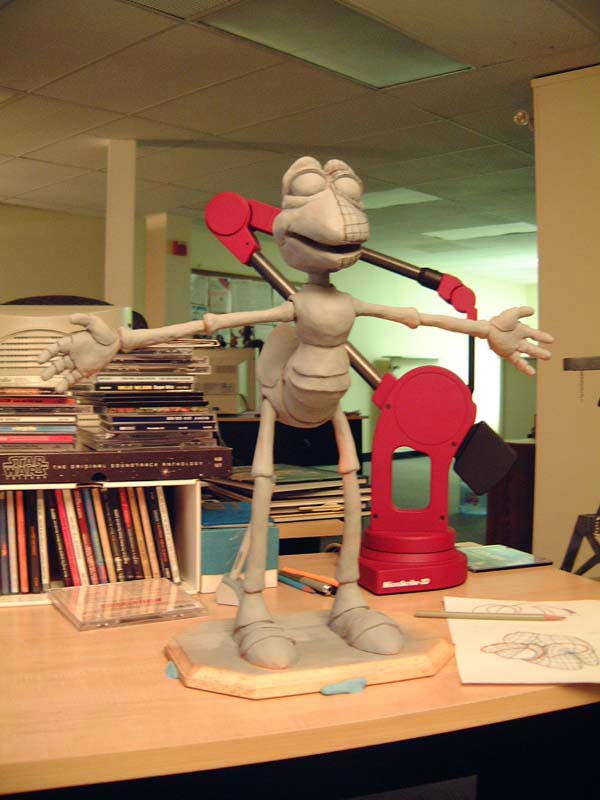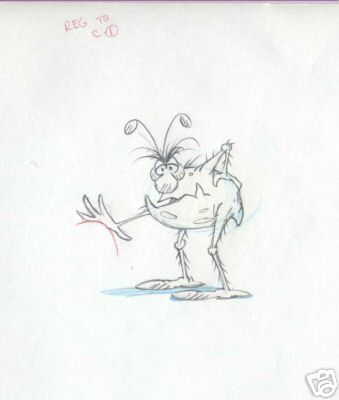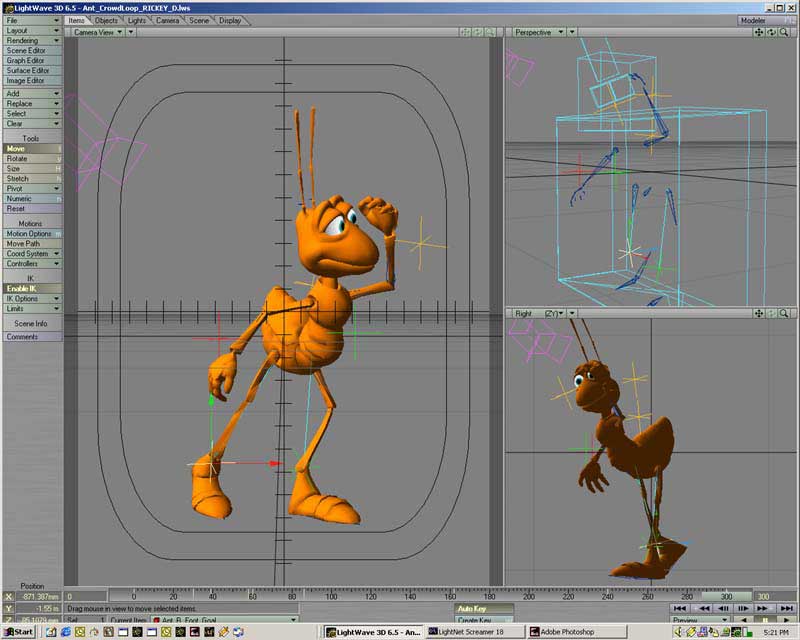2D - 3D The Extra "D" Changes More Than Just The Depth
In day to day discussions among animators there inevitably is the almost casual assertion made "I think I want to try to learn 3D CGI". Certainly there is plenty of anecdotal evidence that 3D CGI animation is the new wave. It would be easy for me to launch off into one of my usual opinionated conversations about the various forms of animation and their equal places at the creative table. But I'll spare you that aesthetic pleasure for another article. Instead I think it might be more interesting to look at some of the major process differences between animating in 2D and animating in 3D, where we can explore how that extra "D" changes more than just the depth.
For the sake of this discussion we will define 2D animation as drawn and 3D animation as modeled and manipulated. Both forms of animation are mostly done on computers although many 2D artists partially create on paper. You will have to forgive some of the generalizations that I will be making here but it is impossible in a simple article to account for every variation or idiosyncrasy of how different artists work. So I will focus on my own personal experience for the most part.

I have always felt that 3D animation is most closely related to stop motion puppetry. Perhaps that feeling comes from the close analogy of modeling and rigging a 3D character to the armature building and sculpting of a clay puppet. Of course the analogy stops as soon as we begin to talk about manipulating the puppet. A clay puppet can be posed and each pose can be fine tuned but essentially that pose is a one time not perfectly repeatable event where as a 3D computer model can achieve the same exact motion identically over and over as long as the manipulation parameters have been saved.
Let's begin by doing a quick review of the drawn 2D process of animating a simple character. For this discussion’s sake I will assume that the character has been previously created and we are just going to be working with this character to deliver some dialogue with appropriate body language and gestures. We begin by making some quick thumbnail sketches to try to get a rough sense of the various poses that we will need. Now taking those thumbnails as guides we start creating the extremes of the action. Perhaps there will be two or three key poses that define this movement. Now we might add in some additional breakdown drawings to create some anticipation and follow through. At this point we can watch the basic action and make some minor timing adjustments. Immediate pencil tests are a real benefit of drawing directly into the computer. We now can add some more breakdowns and moving holds and decide where inbetweens are needed to tighten the spacing for cushions. We can easily reorder drawings or remove weak drawings or add special accent drawings. It is a fragmented process where we can just do some partial drawings to test things and we don't have or need many of the inbetweens yet. This fragmented and iterative approach is one of the true joys of working in 2D as we develop a sense of the motion while checking flows and arcs as we go.

The 3D process is much more isolated. In 2D we can quickly sketch a few lines to rough out a pose. In 3D we have the tedious task of picking, moving, and rotating a significant number of objects to achieve a similar result. A great example is animating a hand. In drawn animation creating a pose is a few quick lines while in 3D there can easily be 20 or more bones to manipulate depending on the model. Now it is true that with very sophisticated rigs a few sliders can be adjusted to position a hand but it is just not the same intuitive feeling. In 2D animation you are focused on the forces working on the character while in 3D it's hard to get away from the feeling of operating a machine made of targets and sliders and bones. In 2D animation the connection between the animator and the character is more about external forces and the motivation behind the action which is very much related to acting. In 3D it seems more like "what lever do I move to make this puppet work".
This really also begins to expose one of the key thought process differences that a 2D animator must resolve when adapting to 3D. In 2D we create the illusion of motion. It is a series of static pictures that are drawn and arranged in such a way as to seem like the character is moving. But in 3D animation the character really moves. In drawn animation you can distort and change drawings however you choose. Squash things, stretch thinks, smear the drawings whatever you need to achieve the illusion and there really are no physical linkages imposed from one drawing to the next. But in 3D you are totally bound by the construction of the model and the "laws" imposed by the rigging and the software. In comparison, 3D for all of its benefits of views and angles is still very restrictive compared to 2D. It just loses a great deal of the spontaneous nature of drawing. Now I realize that for those people who want or need photo realistic motion CGI is a wonderful medium, but so much of what I love about being an animator is the interpretation, caricature and distortion of the real word. When my character runs into a wall he can deform into a puddle and spring back into his original shape. Try doing that with a CGI model.

But seriously, it is very difficult in the 3D world to actually animate pose to pose. It is much more like stop motion in that the actual physical manipulation of the model lends itself better to a straight ahead approach. Keith Lango has written an excellent article on trying to address this issue. Here is his web site, just look in the tutorials section for the article on "Pose to Pose, Organized Key Framing". I highly recommend that anyone entering into 3D work read it. None the less CGI operates more on a continuum while drawn animation is more fragmented and intuitive.
Truthfully, a lot of CGI animators end up thumbnail sketching and planning animations in the same fashion as the traditional 2d animator. That way they can enjoy the spontaneity of drawing and have a much better feeling for the action before they get enmeshed in the world of graph editors and fcurves.
When all is said and done, animating is animating. And although there are quite a few technical hurtles that the 2D animator has to get over to function in the 3D world your ultimate goals are the same. You want to be entertaining and believable in providing that spark of life to your art. But the 2D -3D transition shouldn't be taken lightly and it is more than just a new technical environment. That extra "D" changes more than just the depth.
For the sake of this discussion we will define 2D animation as drawn and 3D animation as modeled and manipulated. Both forms of animation are mostly done on computers although many 2D artists partially create on paper. You will have to forgive some of the generalizations that I will be making here but it is impossible in a simple article to account for every variation or idiosyncrasy of how different artists work. So I will focus on my own personal experience for the most part.

I have always felt that 3D animation is most closely related to stop motion puppetry. Perhaps that feeling comes from the close analogy of modeling and rigging a 3D character to the armature building and sculpting of a clay puppet. Of course the analogy stops as soon as we begin to talk about manipulating the puppet. A clay puppet can be posed and each pose can be fine tuned but essentially that pose is a one time not perfectly repeatable event where as a 3D computer model can achieve the same exact motion identically over and over as long as the manipulation parameters have been saved.
Let's begin by doing a quick review of the drawn 2D process of animating a simple character. For this discussion’s sake I will assume that the character has been previously created and we are just going to be working with this character to deliver some dialogue with appropriate body language and gestures. We begin by making some quick thumbnail sketches to try to get a rough sense of the various poses that we will need. Now taking those thumbnails as guides we start creating the extremes of the action. Perhaps there will be two or three key poses that define this movement. Now we might add in some additional breakdown drawings to create some anticipation and follow through. At this point we can watch the basic action and make some minor timing adjustments. Immediate pencil tests are a real benefit of drawing directly into the computer. We now can add some more breakdowns and moving holds and decide where inbetweens are needed to tighten the spacing for cushions. We can easily reorder drawings or remove weak drawings or add special accent drawings. It is a fragmented process where we can just do some partial drawings to test things and we don't have or need many of the inbetweens yet. This fragmented and iterative approach is one of the true joys of working in 2D as we develop a sense of the motion while checking flows and arcs as we go.

The 3D process is much more isolated. In 2D we can quickly sketch a few lines to rough out a pose. In 3D we have the tedious task of picking, moving, and rotating a significant number of objects to achieve a similar result. A great example is animating a hand. In drawn animation creating a pose is a few quick lines while in 3D there can easily be 20 or more bones to manipulate depending on the model. Now it is true that with very sophisticated rigs a few sliders can be adjusted to position a hand but it is just not the same intuitive feeling. In 2D animation you are focused on the forces working on the character while in 3D it's hard to get away from the feeling of operating a machine made of targets and sliders and bones. In 2D animation the connection between the animator and the character is more about external forces and the motivation behind the action which is very much related to acting. In 3D it seems more like "what lever do I move to make this puppet work".
This really also begins to expose one of the key thought process differences that a 2D animator must resolve when adapting to 3D. In 2D we create the illusion of motion. It is a series of static pictures that are drawn and arranged in such a way as to seem like the character is moving. But in 3D animation the character really moves. In drawn animation you can distort and change drawings however you choose. Squash things, stretch thinks, smear the drawings whatever you need to achieve the illusion and there really are no physical linkages imposed from one drawing to the next. But in 3D you are totally bound by the construction of the model and the "laws" imposed by the rigging and the software. In comparison, 3D for all of its benefits of views and angles is still very restrictive compared to 2D. It just loses a great deal of the spontaneous nature of drawing. Now I realize that for those people who want or need photo realistic motion CGI is a wonderful medium, but so much of what I love about being an animator is the interpretation, caricature and distortion of the real word. When my character runs into a wall he can deform into a puddle and spring back into his original shape. Try doing that with a CGI model.

But seriously, it is very difficult in the 3D world to actually animate pose to pose. It is much more like stop motion in that the actual physical manipulation of the model lends itself better to a straight ahead approach. Keith Lango has written an excellent article on trying to address this issue. Here is his web site, just look in the tutorials section for the article on "Pose to Pose, Organized Key Framing". I highly recommend that anyone entering into 3D work read it. None the less CGI operates more on a continuum while drawn animation is more fragmented and intuitive.
Truthfully, a lot of CGI animators end up thumbnail sketching and planning animations in the same fashion as the traditional 2d animator. That way they can enjoy the spontaneity of drawing and have a much better feeling for the action before they get enmeshed in the world of graph editors and fcurves.
When all is said and done, animating is animating. And although there are quite a few technical hurtles that the 2D animator has to get over to function in the 3D world your ultimate goals are the same. You want to be entertaining and believable in providing that spark of life to your art. But the 2D -3D transition shouldn't be taken lightly and it is more than just a new technical environment. That extra "D" changes more than just the depth.

1 Comments:
"When my character runs into a wall he can deform into a puddle and spring back into his original shape. Try doing that with a CGI model."
Well, actually you CAN.
In fact, you´re describing the two different methods of work for both techniques. 3D has learn a lot from 2D, but it also has to develop his own solutions for the same problem.
The biggest problem with 3D, is that many people still thinks that with the correct software (3dMax, Maya, Lightwave, Blender, you name it) you´re an artist. And many schools offers animation workshop based on THAT idea, and it´s a big lie and a big mistake...
Post a Comment
<< Home